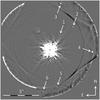| Issue |
A&A
Volume 524, December 2010
|
|
|---|---|---|
| Article Number | L1 | |
| Number of page(s) | 5 | |
| Section | Letters | |
| DOI | https://doi.org/10.1051/0004-6361/201015799 | |
| Published online | 19 November 2010 | |
Online material
[Page 5 is available in the electronic edition of the journal at http://www.aanda.org]
Appendix A: Subtraction of stellar halo with a PSF reference star
 |
Fig. A.1
Reference PSF subtracted image of HD 61005. |
| Open with DEXTER | |
To check that the revealed structures are not artifacts of the ADI methods, a classical PSF subtraction was applied to HD 61005 using the unresolved star TYC-7188-571-1, observed 3 h after HD 61005 in the same observing mode. A total of 400 frames matching the same parallactic angle variation for HD 61005 and the reference star were considered. After shift-and-add, a scaling factor was derived from the ratio of the azimuthal average of the HD 61005 median image to the azimuthal average of the recentered median image of the PSF. The median of the PSF sequence was then subtracted from all individual frames of HD 61005. The resulting cube was derotated and collapsed to obtain the final PSF-subtracted image (Fig. A.1). Additional azimuthal and low-pass filtering was applied to improve the disk detection.
Appendix B: Astrometry of background sources
In addition to our VLT data, we used the HST/NICMOS observations of Hines et al. (2007) (program-10527) obtained in November 20, 2005 and June 18, 2006 to identify the status of the six faint sources detected in our VLT/NaCo field (marked as fs-1, 2, 3, 4, 5 and 6 in Fig. A.1). The relative positions recorded at different epochs can be compared to the expected evolution of the position measured at the first epoch under the assumption that the sources are either stationary background objects or comoving companions. For the range of explored semi-major axes, any orbital motion can be considered to be of lower order compared with the primary proper and parallactic motions. Considering a proper motion of (μα,μδ) = (−56.09 ± 0.70,74.53 ± 0.65) mas yr-1 and a parallax of π = 28.95 ± 0.92 mas for HD 61005 as well as the relative positions of all faint sources at each epoch (see Table B.1), a χ2 probability test of 2 × Nepochs degrees of freedom (corresponding to the measurements: separations in the Δα and Δδ directions for the number Nepochs of epochs) was applied. None of the six sources are comoving
with HD 61005 with a probability higher than 99.99%. They are found to be background stationary objects with a probability higher than 60%. We can therefore fully exclude the possibility that these sources are physically bound companions of HD 61005. Maness et al. (2009) had already determined that four sources visible in their image were background sources. Two of these correspond to fs-3 and fs-4, and we here confirm their result. Their other two sources are outside of our field of view. We therefore provide a new result for the four sources fs-1, fs-2, fs-5 and fs-6.
 |
Fig. B.1
Full field of view of our NACO H-band data reduced by derotating, adding and spatially filtering. Six background sources are identified. |
| Open with DEXTER | |
© ESO, 2010
Current usage metrics show cumulative count of Article Views (full-text article views including HTML views, PDF and ePub downloads, according to the available data) and Abstracts Views on Vision4Press platform.
Data correspond to usage on the plateform after 2015. The current usage metrics is available 48-96 hours after online publication and is updated daily on week days.
Initial download of the metrics may take a while.


